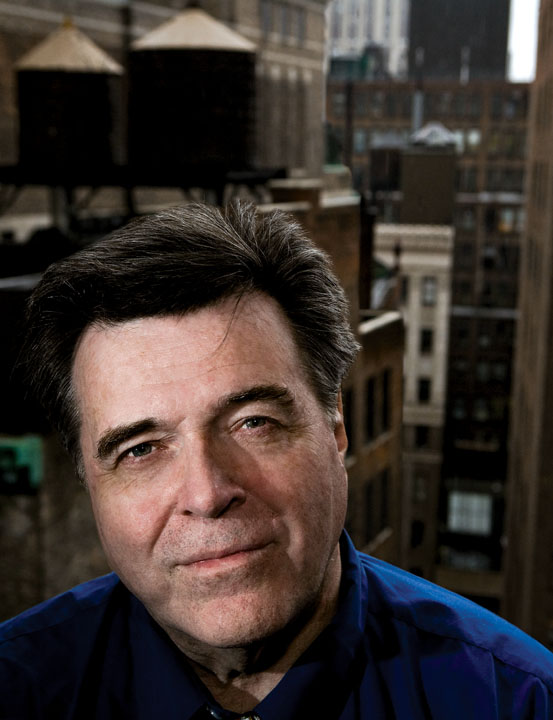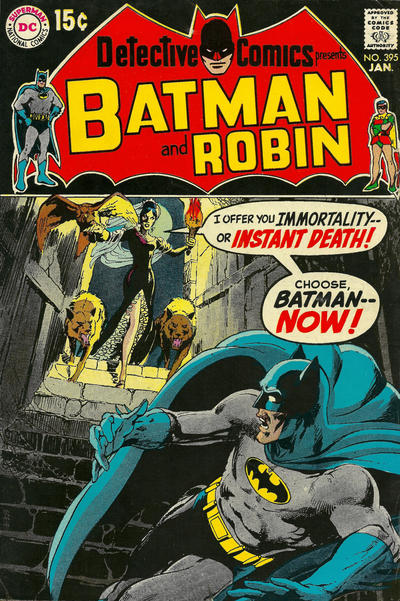I recently had the great good fortune to sit down with legendary artist Neal Adams for a lengthy interview at the Midtown offices of his Continuity Studios. We talked a lot of things, but mostly Batman because, frankly, this was not an opportunity I was going to pass up.

Batfans, this was totally a bucket-list moment, and the best part was Adams’ willingness to not only talk about his time in Gotham but also to look over about a dozen or so of my favorite Batman covers and give his commentary.
I’ve broken up the discussion into an ongoing series, fittingly called THE NEAL ADAMS INTERVIEWS.
If you’re an Adams fan, sit back and enjoy. If you’re a Batman fan just learning about his greatest artist, pull up a chair.

Neal Adams, by the Incredible Seth Kushner, from “Leaping Tall Buildings: The Origins of American Comics,” powerHouse Books.
Bob Kane and Bill Finger created Batman and Jerry Robinson helped refine his look. Great pencillers like Dick Sprang and Carmine Infantino followed. Later there would be Marshall Rogers, Jim Aparo, Frank Miller and David Mazzucchelli. Today, there’s Greg Capullo.
But even through 74 years of history, Neal Adams ranks above them all. His artistic style redefined Batman in the late ’60s and early ’70s and influenced two generations of artists whether they – or even today’s readers – realize it or not.
My very earliest memories of seeing comics on sale at the drug store or the local 7-11 were of haunting covers drawn by Adams. In one, Batman is about to be split in two by a gigantic ax while nearby a stone statue of a Catholic saint weeps. In another, a terrifying grim reaper swings his scythe over a defenseless Robin on the ground, while Batman swings in from behind. Will he make it in time?!
I started on superheroes like most people my age: by watching the Adam West TV show — in my case on Channel 11 after school, several years after the show’s original network run. As a 5-year-old, I had no idea that this was satire. It was brightly colored adventure. Robin was being eaten by a giant clam! Batman just had to defeat the Joker in that surfing contest!
But looking at those covers was something else entirely. These were scary, unsettling. These threats seemed immediate, the stakes permanent. I don’t think I even realized that comic books existed. Batman was a TV show – what was this all about?
I had to have them. And once I got my hands on them, my synapses fired and everything changed. Everything.
I didn’t know who Neal Adams was. I just knew that whoever drew Batman made him look tough, mysterious and heroic all at the same time. He looked like a real person, a dangerous person but not a bad guy. The people around him looked real. The buildings looked real. This wasn’t a cartoon. This was real.
Later, I learned the name of the person who drew the pictures. I also learned that wherever back issues were sold in the nascent world of 1970s comics collecting, the issues he drew cost a premium. A 20-cent comic might go for 5, 10, 20 bucks. Probably more in some cases. It’s hard to remember.
Didn’t matter. I had to have them all. That’s where my allowance went, and later the walking-around money my mother let me keep from my first job selling coffee and hot dogs for tips when I was 13, at a bingo hall in Highland Park, N.J.
Neal Adams.
He was everything to me. The best stories he drew were written by a guy named Denny O’Neil. As it turned out, they were like the Lennon and McCartney of the comics world: superb collaborators who made each other better even if they barely saw eye to eye on almost anything.
I’ve been a professional journalist going all the way back to high school. Not to put too fine a point on it, but I don’t get impressed by celebrities or politicians, really. I mean, it’s always nice to meet them, a perk of the job, but still.
Meeting Neal Adams? That’s something else entirely.
I had the occasion to sit down with Neal (first-name basis!) at his Midtown studios for two full hours ostensibly to talk about his career and his latest work – he’s still in high demand.
But really, I just wanted to talk about Batman. I wanted to ask him questions. And unlike some guys who don’t remember – or say they don’t remember – what everyone else considers some of their most memorable, important, best work, he was very willing to answer all my questions.
So I presented to him about a dozen of my favorite covers. The striking images with all their moodiness, contrasting colors and inherent, sometimes terrifying, drama. And he talked about every one.
Bottom line, it was Adam West who made me a Batman fan. But it was Neal Adams who made me a comic book fan. To this very day.
—
The first cover is from Detective Comics No. 395. It’s not Adams’ first cover depicting Batman, but this one’s significant because it fronts his first collaboration with O’Neil — the gothic horror tale, The Secret of the Waiting Graves, about a mysterious couple searching for immortality through nefarious, druggy (hmm, poppies!) means.
No Egghead or King Tut here.
It’s cover-dated January 1970, which means it came out at the end of ’69. Gone was the campy Batman, whose show was cancelled in 1968. This was a dark Batman, one I would later learn harkened back to the original 1939 concept – and one that would lay the groundwork for the gritty graphic novels on the 1980s, which in turn brought us the Tim Burton Batman and, ultimately, Christopher Nolan’s Dark Knight Trilogy.
DC Comics was already heading in this darker direction after the show was canned. But this is where it started in earnest.
Here are Adams’ comments about one of his earliest classics:
Neal Adams: “Yes, that was our first book together … there are no funny characters or whatever. It was an attempt by Denny, I think, to do a realistic but at the same time fantasy kind of mystery — and to include this idea that these people are looking for immortality related to drugs …
“So we had a really great mix of stuff — dogs that are attacking … It’s very hard for a writer to write a script that consciously allows the artist to show what you can do and so for us to do that first thing and to do the dogs and all that other stuff gave me a pallet on which I can work, that I knew would shock the audience because they had been seeing (camp).
“So there are things that Denny, by writing such a fantastical story, gave me the opportunity to do. Sometimes I don’t even think he thought he was doing it. Sometimes I think he was exercising muscles he hadn’t felt before because he wasn’t really used to doing super heroes per se. He did cops and such.
“It opened certain doors that he recognized he could open in the future and anytime he wanted to, he could just open it up and let me do it and I would go ahead and do it.”
NEXT: The Secret Bat-Origin of Neal Adams. Click here.


Trackbacks/Pingbacks